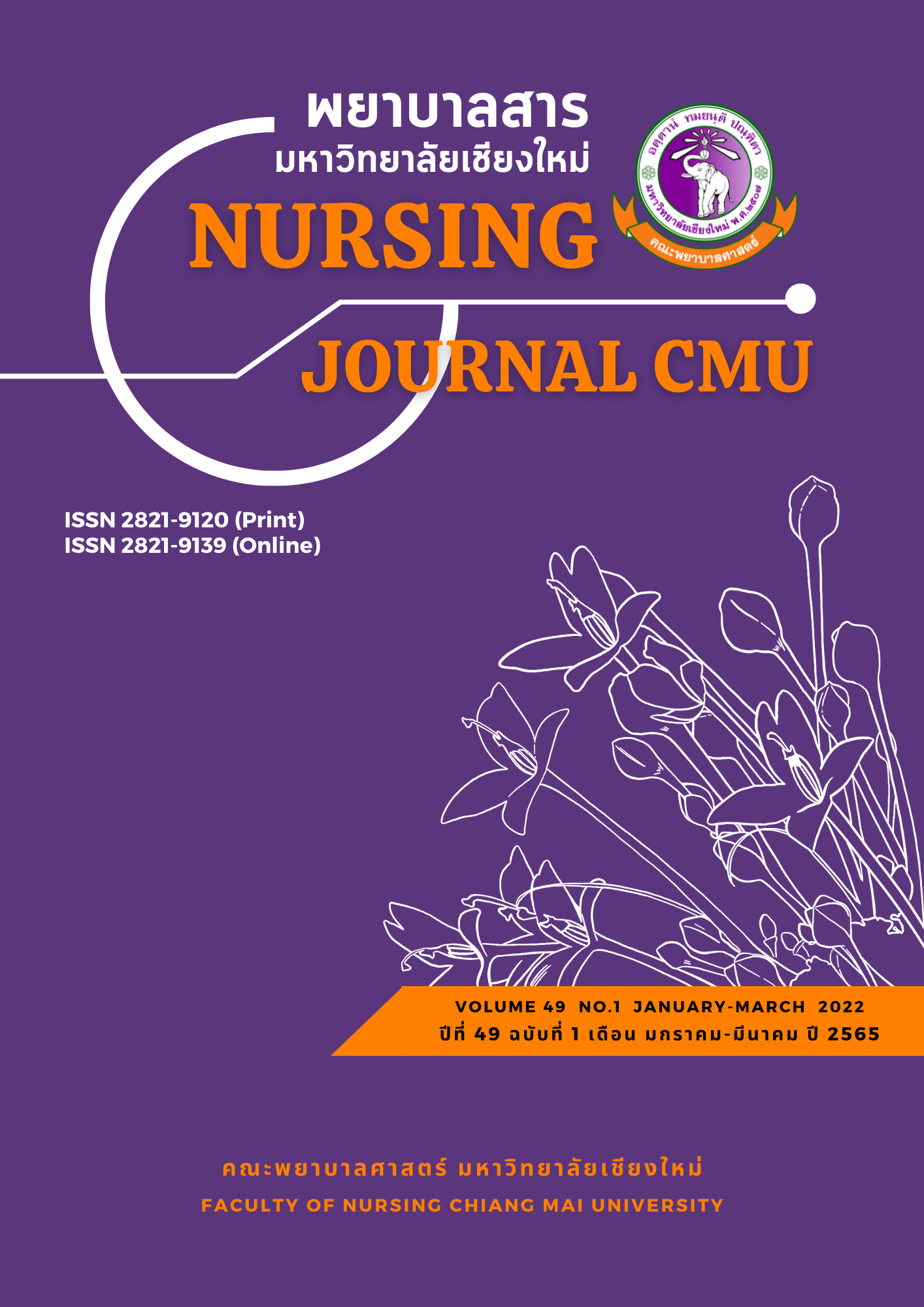Components of Innovative Work Behavior Among First-line Nurse Managers in Private Hospitals and Government Hospitals
Keywords:
Innovative work behavior, First-line nurse manager, Private hospital, Government hospitalAbstract
The objective of this descriptive research was to determine the components of innovative work behavior among first-line nurse managers in private hospitals and government hospitals. The subjects were 400 first-line nurse managers: 200 from private hospitals and 200 from government hospitals recruited using stratified random sampling. The research instrument was a five-point rating scale questionnaire on innovative work behavior with a content validity index of 0.81 and a Cronbach’s alpha coefficient of 0.86. Descriptive statistics, first-order CFA, and second-order CFA were employed.
The results revealed as the following:
1. The numbers of components of innovative work behavior among first-line nurse managers in both types of hospitals were the same (4 components). The construct validity of the instrument was tested and found to be congruent with the empirical data [(x2prvt = 38.02, p-value = .970, GFI = 0.956, RMSEA = .000)] and x2govt = 41.871, p-value = .971, GFI = .9737, RMSEA = .000).
2. The number of indicators of the private hospitals was 13 while that of the government hospitals was 12. Three components had the same number of indicators which were innovative idea exploration (3 indicators), innovative idea generation (3 indicators), and innovative idea implementation (3 indicators). For innovative idea championing, the government hospitals had 3 indicators while the private hospitals had 4 indicators.
The research results indicate that nursing administrators should have a good quality tool with construct validity of innovative work behavior to assess qualifications in creative ideas and in the management of new activities for the development of innovative leadership.
References
Adair, J. (2007). Leadership for innovation: How to organize team creativity and harvest ideas. London: Kogan Page.
Ahmed, K., Ata, A., & Abd-Elhamid, N. (2019). Relationship between the leadership behaviors, organizational climate and innovative work behavior among nurses. American Journal of Nursing Research, 7(5), 870-878.
Anderson, R., Dreu, W., & Nijstad, A. (2004). The reutilization of innovation research: A constructively critical review of the state-of-the-science. Journal of Organizational Behavior, 25(2), 147-174.
Asurakkody, A., & Shin, Y. (2018). Innovative behavior in nursing context. Asian Nursing Research, 12(4), 237-224.
Bass, B. M., & Riggio, R. E. (2006). Transformational leadership. Mahwah, NJ: L.I Lawrence Erlbaum.
Brislin, W. (1986). The wording and translation of research instruments. In W. Lonner. & J. Berry (Eds.), Field methods in cross-cultural research. Newbury Park, CA: SAGE.
Burns, M., & Grove, K. (2001). The practice of nursing research, conduct, critique, and Utilization (4th ed.). Philadelphia: W. B. Saunders.
Contreras, F., Espinosa, C., Dornberger, U., & Acosta, C. (2017). Leadership and employees’ innovative work behavior: Test of a mediation and moderation model. Asian Social Science 13(9), 9-25.
De Jong, J., & Hartog, D. (2008). Innovative work behavior: Measurement and validation. Zoetermeer: Amsterdam Business School.
De Jong, J., & Hartog, D. (2010). Measuring innovative work behavior. Creativity and Innovation Management, 19, 23-36.
Gupta, K., Attri, P., Singh, A., Kaur, H., & Kaur, G. (2016). Basic concepts for sample size calculation: Critical step for any clinical trial. Saudi Journal of Anesthesia, 10(3), 328–331.
Hair, F., Black, C., Babin, J., & Anderson, E. (2010). Multivariate data analysis: A global perspective. New Jersey: Pearson Prentice Hall.
Hammond, M., Neff, L., Farr, L., Schwall, R., & Zhao, X. (2011). Predictors of individual-level innovation at work: A meta-analysis. Psychology of Aesthetics, Creativity, and the Arts, 5 (1), 90–105.
Janssen, O. (2000). Job demands, perceptions of effort-reward fairness and innovative work behavior. Journal of Occupational and Organizational Psychology, 73(3),287-302.
Kaya, N., Turan, N., & Aydin, G. O. (2016). Innovation in Nursing: A concept analysis. Journal of Community & Public Health Nursing, 1: 108. doi: 10.4172/2471-9846.1000108
Kelley, T., Brandon, D., & McGrath, J. (2018). Work arounds as a catalyst toward a culture of innovation. Advances in Neonatal Care 18(3), 163-164.
Kitsahawong, B., Singchungchai, P., & Sritoomma, N. (2020). The development of an innovative work behavior scale for first-line nurse managers in Private Hospitals. Ramathibodi Nursing Journal, 26 (2), 203-216.
Marquis, B. L., & Huston, C. J. (2017). Leadership role and management function in nursing theory and application (9th ed.). Philadelphia, PA: Lippincott William &Wilkins.
Nursing Division, Ministry of Public Health. (2018). Strategic Plans for National Nursing Services 2017-2021 according to the 20-Year National Strategic Plans (Public Health). Bangkok: Suetawan Publishing. (in Thai)
Nursing Division, Ministry of Public Health. (2018). Roles and duties of Registered Nurses. Bangkok: Suetawan Publishing. (in Thai)
Pakokthom, B., & Vorathongchai, K. (2020). Thailand 4.0 competencies for professional nurses working in community hospitals level F1-F3. Journal of Nursing and Health, 38(3), 110-118. (in Thai)
Singchungchai, P. (2019). Innovative leadership in nursing management. The Southern College Network Journal of Nursing and Public Health, 6(1), 260-266. (in Thai)
Thomas, W., Seifert, C., & Joyner, C. (2016). Registered nurses leading innovative changes. The Online Journal of Issues in Nursing, 21(3), 3.
Tung, V., Akkadechanunt, T., & Chontawan, R. (2014). Factors related to innovation behavior among nurses in Tertiary General Hospitals, the Central Region, The Socialist Republic of Vietnam. Nursing Journal 41(2) 117-132.
Xerri, M. (2013). Workplace relationships and the innovative behavior of nursing employees: A social exchange perspective. Asia Pacific Journal of Human Resources, 51(1), 102-123.
Downloads
Published
How to Cite
Issue
Section
License
Copyright (c) 2022 Nursing Journal

This work is licensed under a Creative Commons Attribution-NonCommercial-NoDerivatives 4.0 International License.
บทความที่ได้รับการตีพิมพ์เป็นลิขสิทธิ์ของวารสารพยาบาลสาร
ข้อความที่ปรากฏในบทความแต่ละเรื่องในวารสารวิชาการเล่มนี้เป็นความคิดเห็นส่วนตัวของผู้เขียนแต่ละท่านไม่เกี่ยวข้องกับมหาวิทยาลัยเชียงใหม่ และคณาจารย์ท่านอื่นๆในมหาวิทยาลัยฯ แต่อย่างใด ความรับผิดชอบองค์ประกอบทั้งหมดของบทความแต่ละเรื่องเป็นของผู้เขียนแต่ละท่าน หากมีความผิดพลาดใด ๆ ผู้เขียนแต่ละท่านจะรับผิดชอบบทความของตนเองแต่ผู้เดียว






